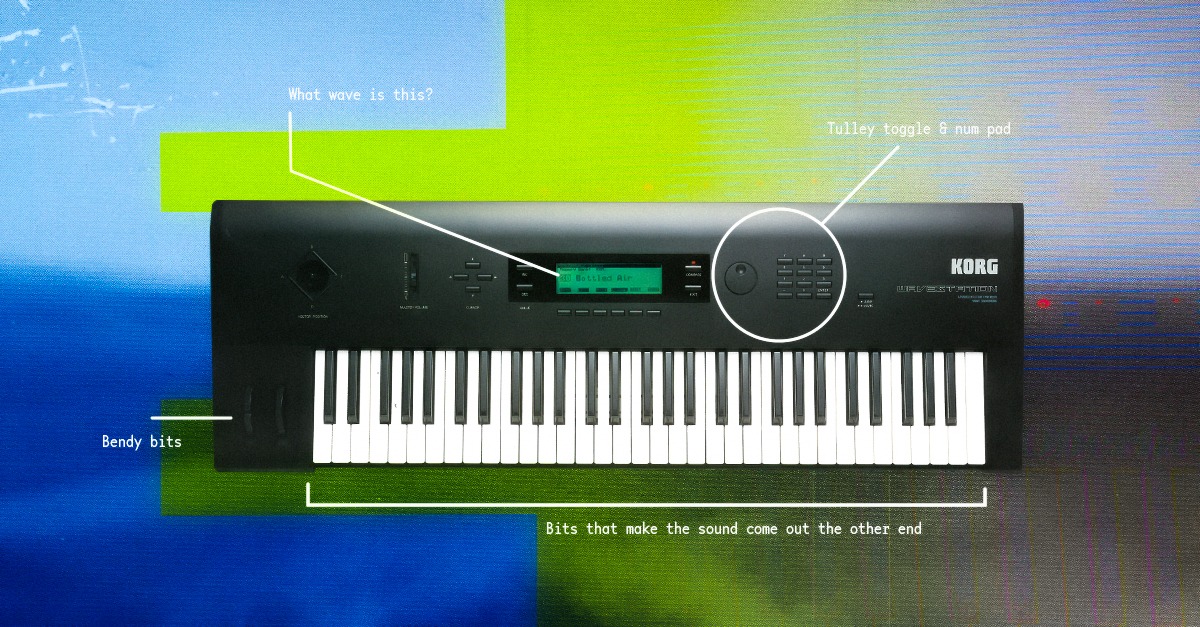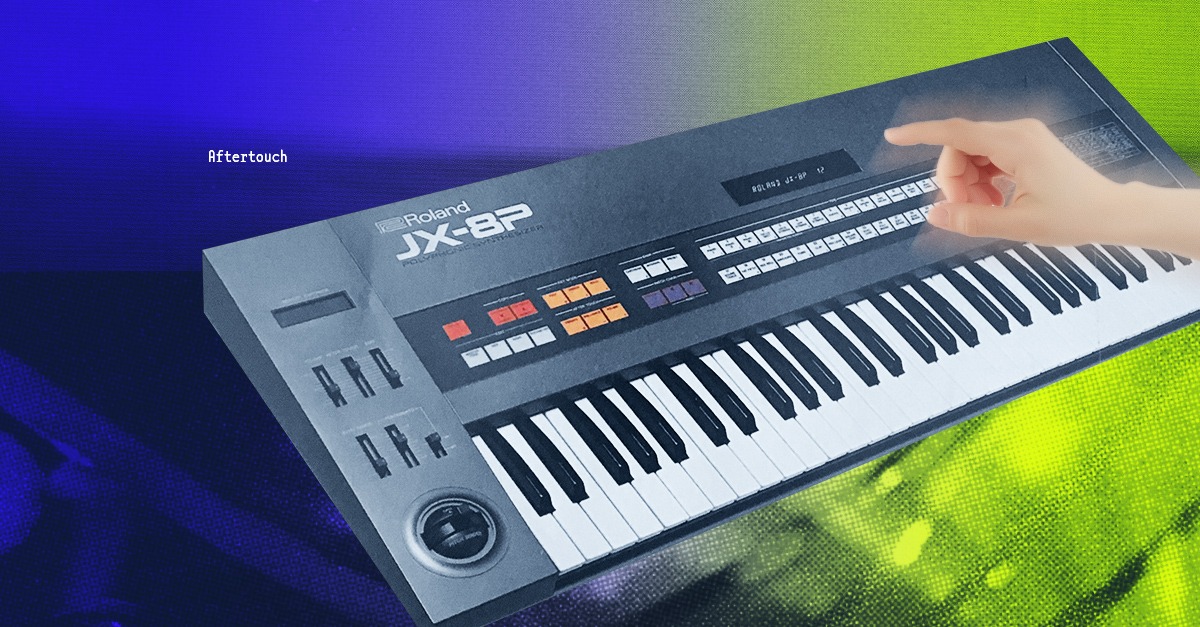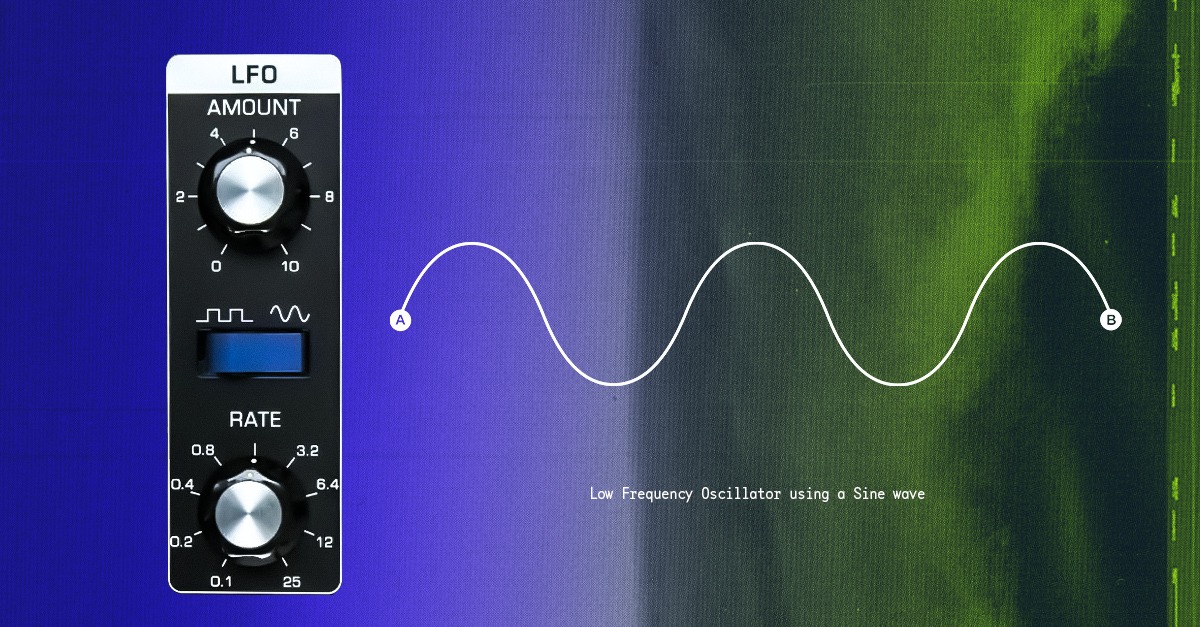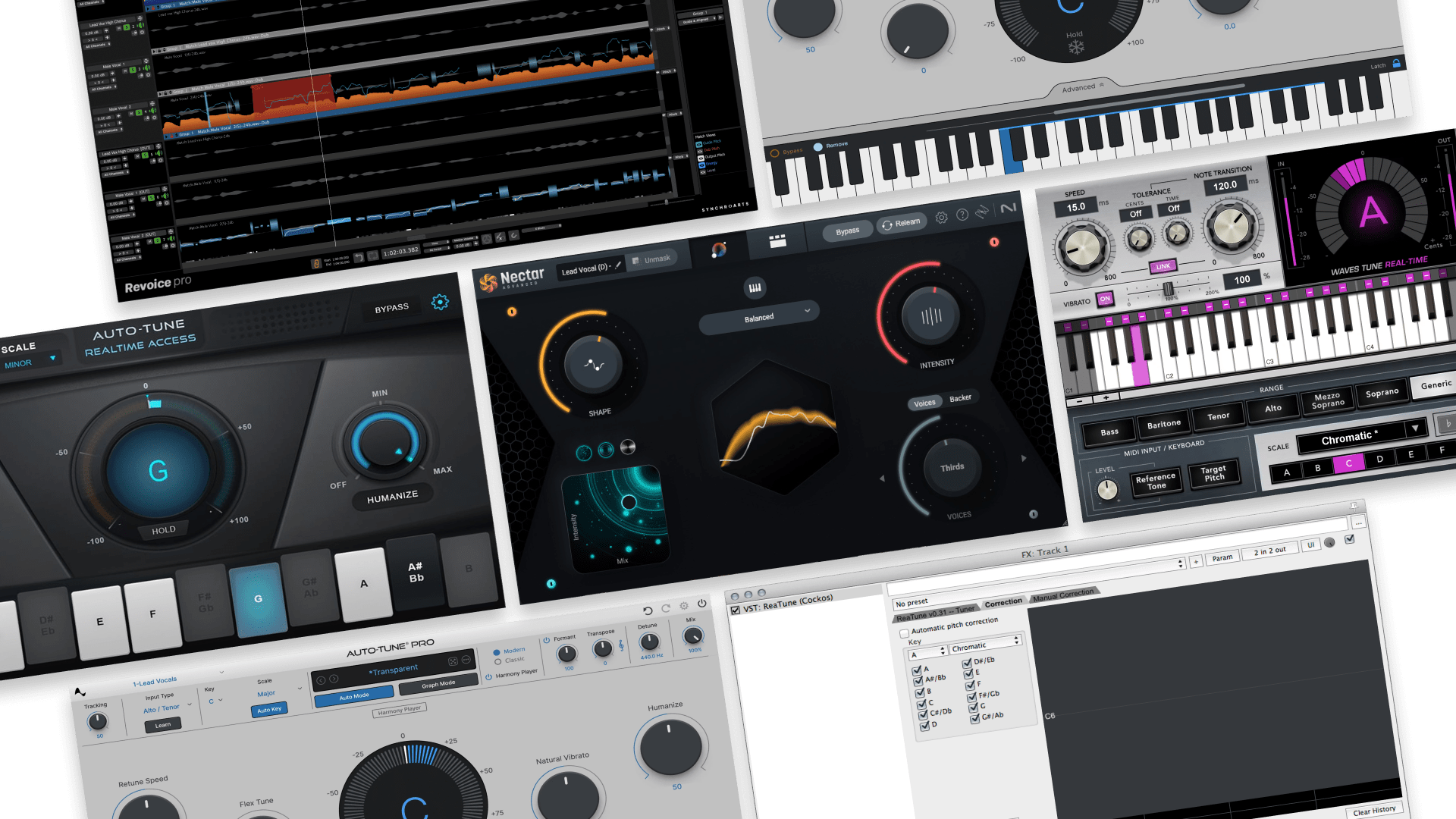
The Ultimate Synth Glossary: 60 Essential Synthesizer Terms

Synthesizers are some of the most challenging musical instruments to use well.
Even basic synth plugins have enough parameters to get completely lost.
But almost all synthesizers are made up of similar component functions.
If you know the name and purpose of each element of a synthesizer you’ll have a much clearer idea of how to make the sounds you’re searching for.
This article is a complete glossary of synthesizer terms. From analog to wavetable, here’s every synth definition you’ll ever need.
Synth Glossary
2-Pole/4-pole – The slope of a synthesizers low pass filter. 2-pole is the gentler 12 dB/octave slope and 4-pole is the more common 24 dB/octave type.
Additive Synthesis – Additive synthesis is a method of generating sound that works by combining multiple sine waves together.
Large numbers of sine waves of different frequencies are required to approximate complex timbres.
Aftertouch – Aftertouch is an additional dimension for adding expression to MIDI information.
Aftertouch is entered by applying pressure to held notes after the notes have already been struck.
Aftertouch is commonly used to create vibrato or other musical gestures that add to the expressiveness of a performance.

Algorithm - An algorithm is an configuration of operators in an FM synthesizer.
Different algorithms rearrange the order of carrier and modulator waves inside the synthesis engine to produce different sonic textures.
Amplitude – Amplitude is the intensity, or volume of a waveform.
If you’re looking at a waveform in a DAW or on an oscilloscope, amplitude will be represented on the y-axis and frequency will be represented on the x-axis.
Envelope generators shape your sound’s amplitude characteristics over type to create expressive tones.
Envelope generators shape your sound’s amplitude characteristics over type to create expressive tones.
Analog – Analog synthesizers create sound using traditional electronics like transistors, op-amps and ICs.
A synthesizer can be considered analog if its audio signal path contains no digital elements.
Analog synths can still contain digital preset management systems, or DCOs.
AM – AM stands for amplitude modulation. Amplitude modulation occurs when the amplifier section of a synthesizer is modulated by an LFO.
Amplitude modulation is often used for tremolo effects.
Arpeggiator – An arpeggiator is a device or plugin that takes a series of notes at its input and cycles through them in a predetermined pattern at the rate defined by a MIDI or CV clock signal.
Band Pass Filter/BPF – A band pass filter is a type of filter that cuts all frequencies except those in a narrow band of frequencies.
Carrier wave - A carrier wave provides the signal for a modulator to act on in an FM synthesizer. Modulators and carriers can be arranged in various configurations known as algorithms.
Clock – Clock is the signal that controls the timing of the functions in a synthesizer. Clock can be supplied by MIDI or control voltage.
Control Voltage – Control Voltage is the electrical signal that analog synthesizers use to communicate between modules such as VCOs, VCFs and VCAs
Cutoff Frequency – Cutoff frequency is the pitch at which a filter begins attenuating frequency content.
For a low-pass filter, the cutoff frequency defines where the high frequencies will begin decreasing in intensity.
DCO - DCO stands for digitally controlled oscillator. Early analog VCOs were expensive and could not always maintain stable pitch.
To produce affordable polyphonic synths that stayed in tune, engineers developed analog oscillators whose pitch could be controlled by a digital source.
These oscillators are still 100% analog—using DCOs does not make a synth a hybrid.
Digital - Digital synthesis takes place entirely within a digital processor. The main methods of digital sound generation are FM synthesis and wavetable synthesis.
Envelope generator – An envelope generator controls how a signal evolves over time. Envelope typically contain controls for attack, decay, sustain and release.
When connected to a VCA, an envelope generator creates the variation in amplitude that gives a sound its identity.
But envelope generators aren’t just for synth loudness. They can be a modulation source for almost any destination you can think of.
Eurorack - Eurorack is a popular format for synth modules in a modular system.
The standard specifications for power and connectivity allow you to build a custom system made up modules from many different manufacturers.
Frequency - Frequency is the number of cycles of a waveform per unit time. Frequency is measured in hertz (cycles per second) for audio signals.
For signals in the audio range, frequency is perceived as pitch.
For signals in the audio range, frequency is perceived as pitch.
FM – FM stands for Frequency Modulation. It’s a method of sound synthesis that creates complex timbres by modulating the frequency of one tone (the carrier) with another one (the modulator).

FM synthesis is responsible for the iconic sound of the Yamaha DX7—the synth that defined the sound of 80s pop.
Gate – Gate is simple on/off messages communicated with control voltage. Gate signals are most commonly used to control note on/off messages from the keyboards of analog synthesizers.
High Pass Filter/HPF – A high pass filter is a type of filter that allows only frequencies above the cutoff frequency to pass. A high pass filter can be thought of as a low cut.
Keytracking – Keytracking changes a patch’s parameters depending on the pitch of the notes being played.
It’s most commonly used to balance the sound of the synth across its entire range.
Keytracking can have positive or negative values that determine whether a parameter increases depending on key position.
The most common application for keytracking is a synthesizer’s filter or VCF.
Lead – A lead is a type of synth patch for creating main melodies. Leads are typically monophonic.
They often have a harmonically rich quality that allows them to stand out in a mix.
LFO – LFO stands for Low Frequency Oscillator. It creates a signal the same way the VCO does except much lower in frequency.
An LFO’s frequency range is so low that it doesn’t sound like a distinct tone like a regular oscillator. Instead the LFO is used as a modulator to change the characteristics of a sound.
Modulating a parameter such as the VCO frequency or VCF cutoff creates movement and action within a synthesizer sound.

Low Pass Filter/LPF - LPF stands for Low Pass Filter. A low pass filter is named for the frequencies it allows through rather than the ones it cuts. That means a low pass is actually a high cut.
Low pass filters take the trebly edge off of aggressive tones like square waves. They’re one of the main tools for shaping frequency content in subtractive synthesis.
MIDI– MIDI stands for Musical Instrument Digital Interface. It’s the digital protocol that allows music gear made by different manufacturers to communicate.
Unlike CV, MIDI can transmit a huge amount of information about a musical performance. Today MIDI is used in almost all synthesizers and digital music gear—it’s an essential piece of music tech!
Mixer – A synthesizer mixer is used to combine the signals from different oscillators or sections of the synth.
Mod Matrix - A mod matrix, or modulation matrix is a synth architecture feature which allows multiple modulation sources (such as LFOs and envelope generators to be routed to different modulation sources in a grid format.
A mod matrix is useful for synthesizers that have many modulation sources—they can be difficult to keep track of!
Modulator wave - A modulator wave provides the signal that modulates a carrier wave in AM or FM. The carrier wave takes on the “shape” of the modulator.
Modular – a modular system is a synthesis architecture made up of of separate modules for each function. Modules are connected by hand using external patch cables to retain maximum routing flexibility.
Most modern modular systems are built using the Eurorack format.
Monophonic – A synthesizer that can only produce a single pitched tone at a time.
Multitimbral – Multitimbral synthesizers are capable of playing more than one sound or patch at the same time.
Multitimbral synthesizers are capable of playing more than one sound or patch at the same time
Noise Generator – Noise generators are a form of oscillator that create a random signal—noise!
Noise in the onset of a timbre can help synthesizers emulate the complex attacks of acoustic instruments.
Oscillator Sync– Oscillator sync allows one oscillator to reset the period of another’s waveform. The result is that both oscillators will have the same pitch even though the slave oscillator’s frequency value is different.
The two oscillators will have the same basic pitch, but the differences in frequency will create additional harmonic partials when the two are summed together with a mixer.
Operator - An operator is a single sound generation module within an FM synthesizer. An operator can act as carrier or modulator wave in various configurations called algorithms.
Paraphonic – A paraphonic synth can produce more than one pitch at the same time but only contains a single VCA and VCF. That means that even though they
Polyphonic – Polyphonic synthesizers are instruments that can play more than one note at the same time. Analog synthesizers typically have fewer voices of polyphony than other methods of synthesis.
Portamento – Portamento is when the pitch changes gradually from note to note. Sometimes called glissando, it creates the effect of “gliding” between notes.
Pulse Width – Pulse width controls the length duty cycle of a square wave. The duty cycle refers to the duration that the wave is in it’s “max” position.
Pulse width modulation is a common synth feature that varies the length of the square wave VCO‘s duty cycle according to an LFO or Envelope Generator.
Pulse width mod can create a smooth modulation sound similar to a chorus effect.
Q Factor – Q factor, or “quality” factor is a parameter that describes how wide or narrow a filter’s centre of action is. You can think of Q like the bandwidth of a filter.
In a synthesizer’s filter, the Q factor parameter is called resonance.
Quantize - Quantize is a feature that appears in hardware and DAW-based sequencers.
Quantizing notes snaps them to the subdivisions of the bar/beat grid they are closest too, ensuring the sequence plays back in perfect timing based on the clock signal.
Resonance – Resonance is the Q or “quality factor” of a synthesizer’s filter. Increasing the resonance produces an EQ-like boost around the cutoff frequency.
Resonant filters with a steep 4-pole slope can have radical effects.
Resonant filters with a steep 4-pole slope can have radical effects.
Ring Mod - Ring Mod is a type of amplitude modulation created by multiplying two signals together. Ring modulation produces distinct “side-bands” that have a metallic robot-like sound.
Ring mod is famous for creating the sound of the Daleks from Dr. Who.
Sample and Hold – Sample and hold is a circuit that locks or freezes the voltage of an incoming signal.
Sample and hold produces a unique signal that can act as a modulation source for many other elements in a synthesizer.
Sawtooth Wave – Saw waves are one of the basic wave shapes that an oscillator can emit to form the basis of a sound in subtractive synthesis.
Saw waves are richer in harmonic content than sine waves, making them good candidates for subtractive synthesis techniques.
Sequencer - A sequencer is a device or plugin that stores the MIDI or CV information used to control notes on/offs or parameter changes over time.
Many synthesizers feature onboard sequencers for creating musical passages.
Sine wave – A sine wave is the most basic type of simple waveform.
Sine oscillators are sometimes not included on analog synths since sine waves can be synthesized subtractively using a triangle wave oscillator and VCF.
Sine oscillators are sometimes not included on analog synths since sine waves can be synthesized subtractively using a triangle wave oscillator and VCF.
Slew Rate – Slew rate is the speed at which a parameter can respond to changes in amplitude. Deforming of a wave shape can occur if the changes in amplitude are faster than the amplifier’s slew rate.
Super saw – Super saw is a type of patch common in trance music that consists of a series of saw waves detuned by different amounts and summed together to create an enveloping sound.
The super saw sound was popularized by the 90s-era Roland JP-8000 synth. It’s a form of unison patch.
Subtractive Synthesis - Subtractive is the main synthesis method used in analog synths. Subtractive synthesis begins with a complex waveform like a square wave that’s rich in harmonics.
Complex timbres are created by filtering out (or subtracting) frequency information using a filter.
Triangle Wave - A triangle wave is a basic waveform shape emitted by an oscillator. Triangle waves have less harmonic content than square or saw waves, but they’re still useful in subtractive synthesis—especially for
Trigger - A trigger is a type of on/off signal similar to gate. Instead of the latching signal needed to convey the press and release of a keyboard key, trigger produces a brief pulse signal.
Unison – Unison mode sets each oscillator on a synthesizer to the same frequency
VCA – VCA stands for Voltage Controlled Amplifier. A VCA deals with the amplitude level of your synth sounds.
A VCA normally accepts voltage input from an envelope generator to create variation in the synth’s level over time.
These variations have a surprisingly large influence on the character of the sound.
VCF – VCF stands for Voltage Controlled Filter. A filter is the tool you use to shape the tonal balance of a sound.
Filters come in several different styles. The most common type is a low pass filter or LPF. A low pass filter is named for the frequencies it leaves unaffected, rather than those it cuts.
That’s the same for other types of filter like high pass and band pass.
If you start with a rich tone from an oscillator like a square or sawtooth wave your synth’s VCF can do a lot of tone shaping by filtering out frequencies.
This technique is called subtractive synthesis. It’s the basis of the method used for most analog synthesis.
VCO – VCO stands for Voltage Controlled Oscillator. Oscillators are the building blocks of synths.
They’re the basic tone generators that will make up your synth sounds. Oscillators typically emit simple waveforms like Square, Saw, Triangle and Sine.
Velocity – The intensity with which a key is struck. MIDI note on messages carry a velocity value even if you don’t enter them using a keyboard.
Varying the velocity of different MIDI notes in a passage is one way to humanize a performance.
Varying the velocity of different MIDI notes in a passage is one way to humanize a performance.
Vocoder – A vocoder is a device or plugin for transposing timbral characteristics of a human voice onto the texture of a synthesizer.
Voice - A voice is a single path within a synthesizer for creating a pitched sound. Monophonic synthesizers have a single voice while polyphonic synthesizers have several, depending on how many notes of polyphony it can produce.
Each voice in a polyphonic synthesizer is a parallel signal path with it’s own oscillator, amplifier and filter.
Each voice in a polyphonic synthesizer is a parallel signal path with it’s own oscillator, amplifier and filter.
Wavefolding - Wavefolding is a unique style of synthesis and sound shaping that works by clipping an incoming waveform to produce “folds” that introduce new and unpredictable harmonics.
Wavetable - Wavetables are digital lookup tables used as the sound generation element in wavetable synthesis. A wavetable holds each sample in a single cycle waveform and a “pointer” cycles through the cells at different rates to produce new pitches.
Synthesized words
Synthesizers are one of the most exciting things about music production.
Synthesis might seem intimidating at first, but if you know the key terms you’ll have a clearer picture of how it works.
Refer to these terms the next time you stumble on a confusing synth situation, you might find your way to the tone you’ve been searching for!
Gear guides, tips, tutorials, inspiration and more—delivered weekly.
Keep up with the LANDR Blog.



